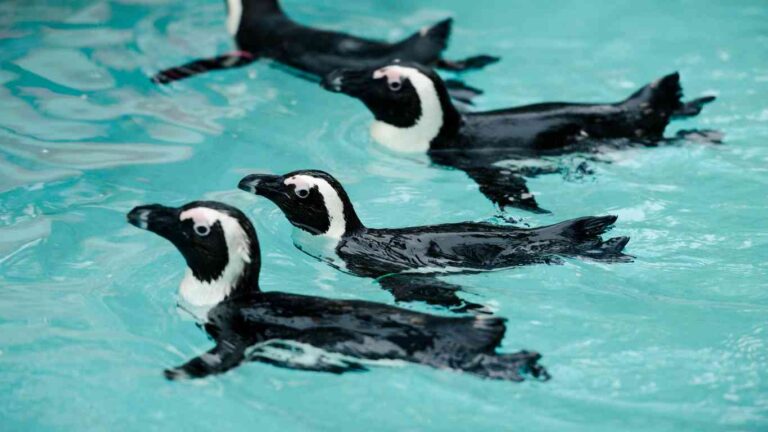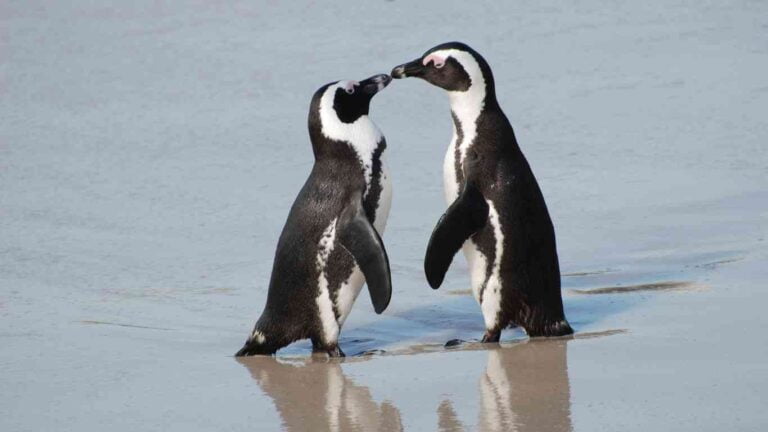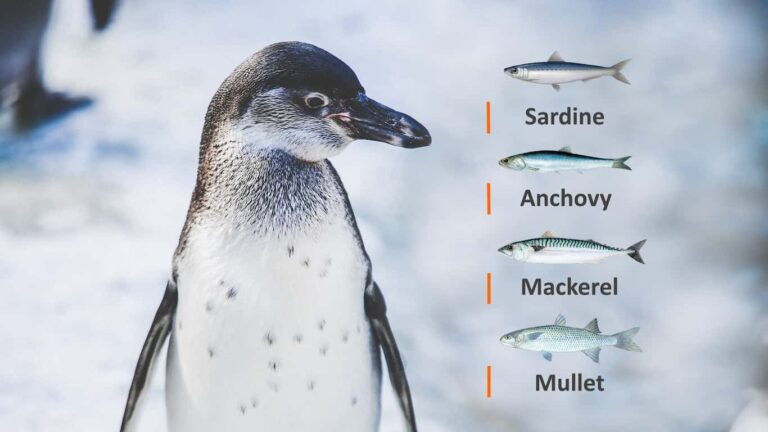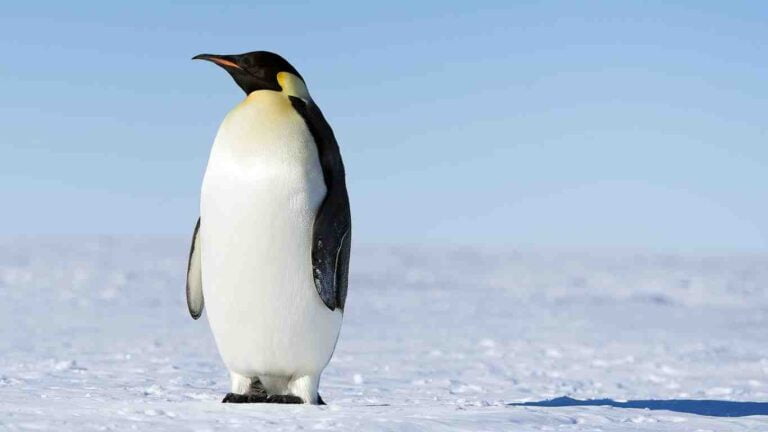9 Things Penguins Eat in the Wild
Penguins are fascinating creatures that have adapted to live in some of Earth’s most extreme environments.
Their unique feeding habits play an important role in their survival, and their diets vary depending on their species and location.
From fish to krill, penguins eat a range of foods that help them thrive in harsh climates.
List of Things Penguins Eat
Penguins eat marine life, which includes fish, krill, shrimp, crab, squid, cuttlefish, amphipods and jellyfish. Sardines, sprats, cod, anchovies, and mullet are some of the small fish they like to eat.
Penguins spend a significant amount of time in water. This is where they find their food. The makeup of a penguin’s diet can vary greatly.
Each penguin species has its own preferred menu that is influenced by its habitat and the availability of certain prey.
Here is a comprehensive list of foods or diets penguins eat to survive:
1. Krill
Penguins eat krill. They are a vital food source for many penguin species. Species like the Adelie, Chinstrap, and Gentoo penguins frequently feed on krill.
Krill is a small crustaceans found in the Southern Ocean. They form an integral part of the penguin’s diet.
Krill constitute an immense biomass and are a key nutritional source for several penguin species.
Due to their abundant nature, krill supply the necessary energy penguins need to maintain their daily activities.
2. Shrimp
Many penguin species eat shrimp as part of their daily diet. It’s an important part of their diet. But shrimp is not penguins’ main marine food source.
Penguins enjoy shrimp due to their abundance in the ocean waters. These small crustaceans offer vital nutrients like protein and energy.
Shrimp inhabit the seabed along many coastlines and estuaries. They gather in great numbers around food-rich coastal areas.
Penguins catch them during their frequent diving sessions. They chase and catch individual shrimp actively swimming or on the ocean floor.
3. Crab
Penguins occasionally eat crabs, though they are not the primary food source. Species like Humboldt and Galapagos penguins have been seen to feed on crabs.
These birds inhabit areas where crabs are plentiful, such as rocky coastlines and shallow intertidal zones.
Crabs typically dwell in regions where the water is teeming with seaweeds and rocks, offering them shelter.
During low tides, opportunistic penguins may hunt for these crustaceans in the shallow waters of rock pools and coastal reefs. Crabs offer high protein content, making them a beneficial if irregular part of penguin diets.
However, not all penguin species have access to crabs as a food source. This availability largely depends on the geographic distribution of both penguins and crabs.
4. Amphipods
Penguins eat amphipods a type of small crustaceans similar to krill. They can be found in the deep waters, intertidal zones and shallow waters of Antarctic and Atlantic ocean where penguins live.
They inhabit all over the sea, lakes and rivers including moist areas on many tropical islands.
Adélie and Gentoo penguins, have been observed eating amphipods. King Penguins also feed on them in the southern Atlantic and Indian Oceans.
These tiny crustaceans are an important part of the diet for smaller penguin species like the fairy penguin. For young penguins they are an easily caught prey.
Though not the primary diet, amphipods are consumed when other more substantial prey might be scarce. Larger penguins have also been known to eat the larger amphipods they can find.
Amphipods being widely distributed, are an accessible prey for coastal penguin species too.
5. Squid
Penguins will eat squid anytime it is available. Emperor and King penguins often feed on squid. These larger penguins dive deep to pursue their agile prey.
Other species, like the Adelie and Gentoo penguins live in areas rich with squid, which they expertly catch near the surface or at moderate depths.
Patagonian squid live in the southeastern Pacific and southwestern Atlantic. Humboldt and Magellanic penguins feed on Patagonian squid in these southeastern waters.
Squid flourish in diverse marine environments worldwide. Many squid species prefer the open ocean’s mid to deep-water habitats. Others like Shortfin squid may be found closer to coastal areas where penguins typically forage.
6. Cuttlefish
Yes, penguins eat cuttlefish as part of their diverse food choices.
Cuttlefish thrive in warm, shallow waters preferable to coral reefs and seagrass beds. Some species can also be found in colder, temperate seas, expanding their reach to temperate zones.
Penguins that live in warmer, temperate, and tropical regions may encounter a variety of cuttlefish and eat them alongside their main diet.
Cuttlefish are a secondary food source for penguins. They are eaten when opportunistic penguins such as Yellow-eyed, Galapagos and African penguins encounter them.
Rich in protein, eating cuttlefish benefits penguins’ nutrition, aiding in their survival in dynamic oceanic ecosystems.
7. Octopus
Penguins eat octopus and they serve as an occasional meal for some penguins. Emperor Penguins are known to hunt them.
Coastal waters of the Antarctic are home to smaller species of penguin. Here, the Adélie Penguins frequently pursue and consume octopus. Octopus availability is limited by quantity and geographic distribution.
They inhabit many ocean regions, from coral reefs to the deep sea. They are versatile and can thrive in both tropical and cooler waters.
African penguin may eat octopus. They live in areas where octopuses are present. Octopus is not a primary food source but can be opportunistically hunted by penguins.
The consumption of octopus by penguins varies depending on local biodiversity and individual hunting skills.
8. Jellyfish
Penguins occasionally eat jellyfish, quite negligibly. Species like Adélie, yellow-eyed, Magellanic and little penguins, are known to feed on jellyfish.
Penguins typically seek out more nutritious food such as fish and krill, since jellyfish are not very nourishing. They do not actively seek them out as food.
Jellyfish drift in almost every sea, varying widely in size from the surface to the deep sea. They are common in coastal regions and tropical waters too.
While jellyfish are common, they are not a significant part of most penguin diets. Antarctic penguin species, like the Emperor and Adelie, mostly consume krill and fish. These species live in regions with minimal jellyfish presence.
9. Fish
Penguins primarily eat fish, particularly sardines, sprats, cod, anchovies, mullet, and Antarctic silverfish.
Humboldt and African penguins which live in milder climates prefer sardines and anchovies, while Emperor and Adelie penguins in the colder polar areas often eat Antarctic silverfish.
Sprats are also a significant part of penguin diets, especially in cooler waters. Cod fish is occasionally consumed by penguins, particularly in colder northern seas.
Mullets are also a small part of penguin diets, often consumed when other food sources are scarce.
Fish play a crucial role providing essential nutrients for penguins’ survival. Nearly all penguin species rely on and eat fish. However different penguin species eat varying types and quantities of fish influenced by their location.
(Featured image by Christopher Michel on Flickr; Modified)







